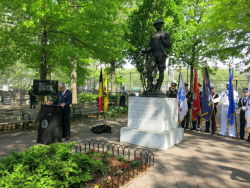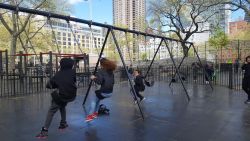De Witt Clinton Park
The Daily Plant : Friday, May 22, 2015
At Clinton War Memorial Flanders And New York Remember Those Making The Ultimate Sacrifice

The sun shone down through the canopy of trees. In a solemn yet celebratory ceremony veterans and civilians, foreign dignitaries and local officials gathered Tuesday, May 12 at the Clinton War Memorial doughboy in DeWitt Clinton Park. Burt Johnson’s poignant sculpture of an infantryman gazed down as the famous poem by Lieutenant Colonel John McCrae, In Flanders Fields, was recited a century after it was composed.
An ongoing gift of $70,000 from the Government of Flanders supports seven years of care for the historic doughboy sculpture as well as upkeep of its landscaped setting at the southeast park entryway. The event honored local war heroes as part of a series of events organized by the Government of Flanders, Belgium, through Flanders House, to commemorate the Centennial of World War I.
In June 1917, the arrival of the American Expeditionary Force tipped the balance in favor of the Allied Forces towards the middle of 1918. The four American divisions, 40,000 men in all, who fought in Flanders, arrived in Europe in June and July 1918, suffered heavy losses in the region.
This year the annual ceremony was graced with the presence of the Geert Bourgeois, Minister-President of the Government of Flanders, who in his remarks touched upon our need to remember the deeds and losses of World War I. Also speaking were Loree Sutton, Commissioner, NYC Mayor’s Office of Veterans Affairs; Colonel Joseph Davidson, Commander at Ft. Hamilton; Ambassador Guillermo Rishchynski, Permanent Representative of Canada to the United Nations; Dr. Libby O’Connell, Commissioner, United States World War I Centennial Commission; and NYC Parks Manhattan Borough Commissioner William T. Castro. NYC Parks Art & Antiquities was also instrumental in arranging this event as well as the continuing preservation of the sculpture.
The recitation of the poem In Flanders Fields (whose final lines are inscribed on the base of the monument) was performed by Elizabeth Turner, a direct descendant of Lt. Col John McCrae, and the ceremony included a color guard and rendition of “Taps” to close the event. Also in attendance was Amy Schwarz, the grand-daughter of Burt Johnson, as well as numerous dignitaries and veterans.
The monument, completed in 1930, was commissioned by the Clinton District Association as a memorial to those young men from the neighborhood who died in World War I. The monument features a pensive infantryman known as a “doughboy” holding poppies in his right hand and a rifle slung over his left shoulder.
The term doughboy was widely popularized in the United States during World War I (1914-1918) to refer to infantrymen. After the war numerous communities commissioned doughboy statues to honor local war heroes. The Clinton War Memorial is one of nine such statues erected in New York City’s parks.
Burt Johnson was born in Flint, Ohio. He studied with noted sculptors James Earle Fraser and Louis Saint-Gaudens, Johnson’s brother-in-law, whose sibling was the renowned artist Augustus Saint-Gaudens. Johnson received many public commissions from coast to coast, and also created the statue for the Woodside Doughboy (1923) in Doughboy Park in Queens. The Clinton War Memorial doughboy was situated at the highest point of the historic park which at the time served a densely populated working-class tenement district that abutted an active waterfront.
McCrae, a Canadian army doctor, wrote In Flanders Fields following the death of his close friend and compatriot Lieutenant Alexis Helmer, and its sentiments have resonated for generations. The image of poppies has become a universal symbol of loss and remembrance.
In a speech at Pomona College in 1924, Johnson commented on the important neighborhood and societal role of statues such as this: “Civic sculpture, its subject, its placement and its execution make it a part of the life of the community.” It is a tribute to Johnson’s artistry that though the city and neighborhood may have evolved, his doughboy’s emotive power has endured for future generations.
For more information about Parks’ historic monuments citywide, including the Clinton War Memorial visit www.nyc.gov/parks.org. For more information on Flanders House New York visit http://www.flandershouse.org/in-flanders-fields.
QUOTATION FOR THE DAY
“If ye break faith with us who died
We shall not sleep, though poppies grow
In Flanders fields.”
Lt. Col. John McCrae
(1872-1918)
Check out your park's Vital Signs
Clean & Safe
Green & Resilient
Empowered & Engaged Users
Share your feedback or learn more about how this park is part of a
Vital Park System










